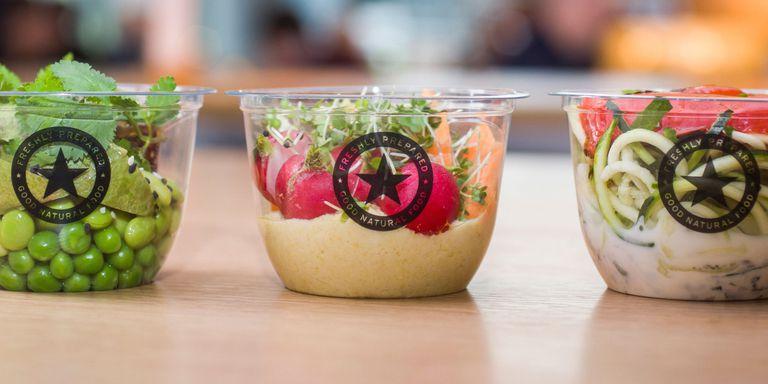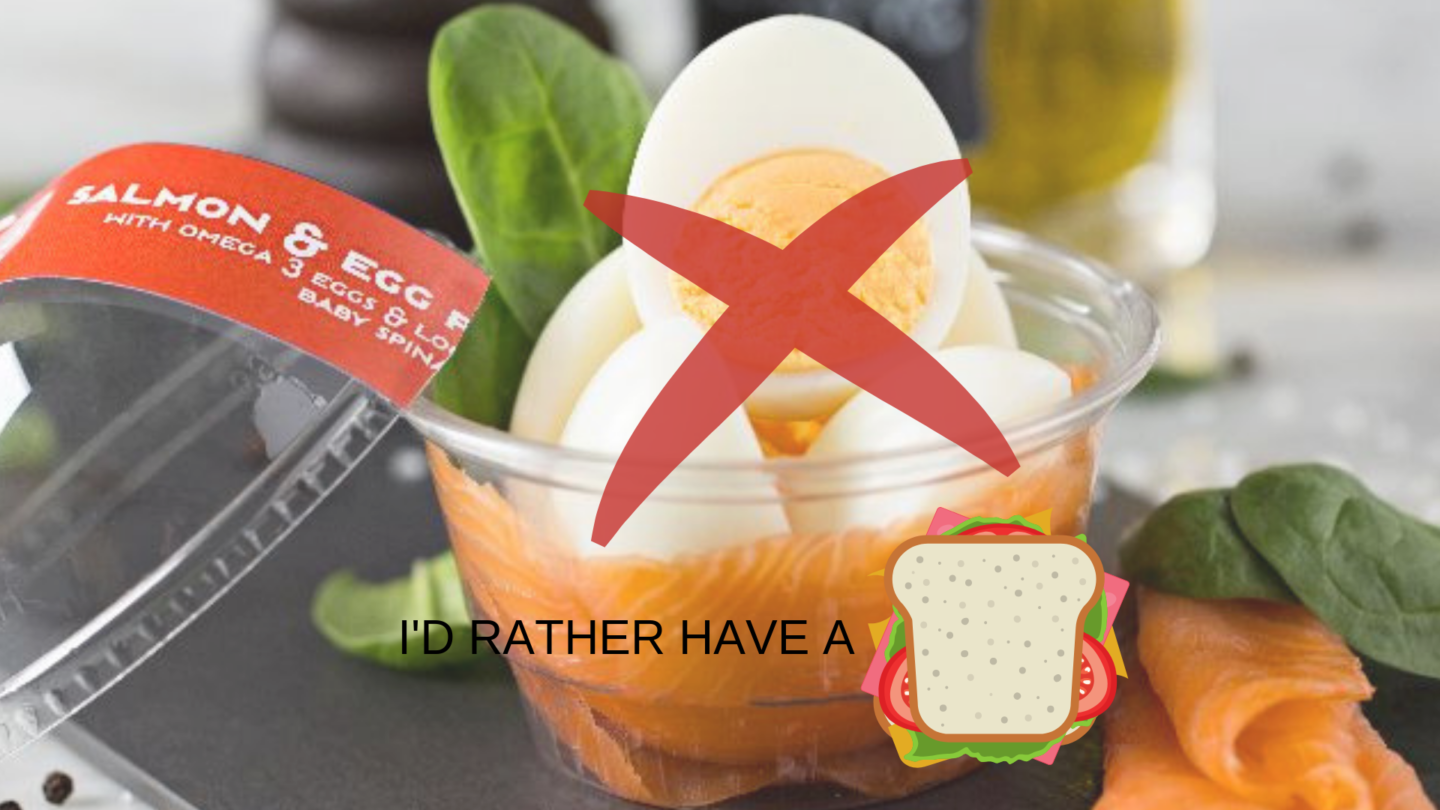
*TRIGGER WARNING* THIS POST WILL DISCUSS CALORIES
Hi Instagram, I have a bone to pick. Is there a reason why your ‘sophisticated’ algorithm sees it appropriate to bombard a former anorexia patient with adverts for starvation tool kits? In the past week and a half, I’ve had unnamed annoying Essex man’s weight loss book, a ‘body boot camp’ programme and Pret’s 250 calorie winter soups. Okay so ‘starvation toolkit’ may be a bit much re the silly man’s latest vegetarian endeavour and Abs-Mcgee’s camel toe parade. But when it comes to Pret’s latest lunchtime offering, I stand firmly by my accusation. Unprovoked, dietitian Ursula Philpott confirmed my suspicions. ‘It’s not dissimilar to those meal replacement shakes you get for weight loss,’ she told me.
‘250 calories is a snack, not a meal.’
But Pret is not the only retailer to offer up measly pots of vegetables and water and market them as a nutritious, satisfying lunch. Itsu’s ‘detox’ noodle soup comes in at a piss poor 157 calories, whilst Wasabi’s chicken gyoza soup will provide a mere 231, and their vegetable soumen around 124. Then there’s the shelves of plastic pots, home to a delicious boiled egg, three spinach leaves and a slice of smoked salmon. Maybe two if you’re lucky (and willing to pay £3 for it). Whilst this array may delight sporty types in need of some between-meal sustenance, I’m not 100 per cent convinced that such products are aimed at those, appropriate consumers. Rather, I feel, it’s the anxious, worried well who spend at least 30 minutes of their day deliberating which lunch choice would be ‘healthiest’. All this rumination leaves them achingly hungry, so they dart out to grab a sandwich only to be faced with a full display of calorie information; a niggling little footnote attached to every desire. If there’s a 230 calorie option available – and it’s ‘healthy!’ – (says Pret) then you should probably be eating it. After all, it’s ‘good’ for you, right?
Wrong. ‘Dietary experts recommend eating, roughly speaking, 300 calories for breakfast, around 400 to 500 for lunch and then about 600 for dinner, interspersed with a couple of 200 calorie snacks throughout the day,’ says Ursula.
‘And maybe 100 or so throughout the day as hot drinks and beverages.’ This model, Ursula explains, is widely accepted by scientists – and Public Health England – to be the most effective way to maintain body weight for an adult woman. The numbers are slightly higher for men.

‘People try and skimp on lunch and dinner and end up either eating more throughout the day or just being hungry. We’d much rather you had an extra slice of bread at lunch and were sufficiently full.’ In other words, a Sainsbury’s prawn mayo sandwich and a packet of crisps for lunch will work out far healthier in the long term than subjecting yourself to that on-trend, watery, tepid concoction. Hell, even for those on a weight-loss diet, a 300 odd calorie lunch is still not enough. ‘For a small number of people who are advised to lose weight for health reasons, we instruct eating about 1,200 calories daily which usually just means swapping out snacks for something lower in calories. 300 at lunch would leave you hungry.’
BUT…LITTLE AND OFTEN?
Health conscious retailers may insist their low-calorie options are intended to appeal to those of us who favour a ‘little and often’ way of eating. Perhaps we eat several meals per day rather than three. But the dietitian-recommendations are there for a reason. Whilst there is no conclusive evidence that one particular frequency of eating or time schedule is supreme, many studies show the benefits of regular, high-quality meals.
A 2012 analysis by researchers from the University of Tennessee found that those eating three meals and two snacks had lower risk of metabolic disease and maintained their weight, compared to those eating four or five times throughout the day. Another recent study, published in the New England Journal of Medicine found that when participants eat a certain food out of a snack-sized pack, as opposed to as a main meal, they’re more likely to eat over their calorie limit throughout the day.
Other studies show teenagers who regularly skip meals or eat ‘irregularly’ throughout the day are more likely to be obese or overweight. And even more intriguing, a 2017 study by researchers at the Academy of Nutrition and Dietetics in the US found snack foods labelled with nutritional benefits to be particularly problematic. When a snack was labeled with a nutrition claim, particularly vitamin-fortification, participants were more likely to a) purchase it, b) not look at any other nutritional information on the packet and c) buy a less-nutritionally sound product.

And we do know our bodies are happier and healthier when eating according to our circadian rhythms. Our circadian rhythm (body clock) determines the schedule of functioning for just about every cell our bodies. This includes the rate and efficiency of food processing. Some studies have shown that our bodies may be better equipped to process calories earlier in the day, as opposed to late in the evening, however this research is still in its infancy.
Ultimately, our circadian rhythms have adapted to our modern way of living. Most people begin their day in the morning and go to sleep at night. We need most of our calories to provide us with energy during the day and to keep our bodies ticking over during an eight hour (if you’re lucky) fast every night. Hence, eating three, balanced meals per day is a relatively simple way to provide a consistent amount of energy. As dietitian Duane Mellor explains: ‘Meal patterns have developed with society with industrialisation. It is better to have a good alignment with your body clock and follow your bodies cues. A balanced chronology [of meals] is logical.’
For those of us recovering from an eating disorder, of which there are now an estimated 1.25 million – there’s little doubt that any message promoting dietary restriction is damaging. Eating decent-sized, regular meals is crucial for physical, cognitive and emotional recovery. When I first came out of hospital, I stuck religiously to the same 350-calorie chicken soup for my al’desko lunch. Colleagues didn’t bat an eyelid – ‘she eats lunch everyday, therefore she’s recovered,’ they thought.
Little did they know those pesky numbers written on the soggy packaging were keeping me stuck. Stuck in my narrowed existence in which food still reined supreme and my desires, wants and needs were not worthy of attention. It took months (and shit loads of therapy) before I could finally grant myself the medicine my mind and body needed to knock down those barriers: a chicken salad sandwich. Marks and Spencers’ is best FYI. I couldn’t even tell you how many calories are in it. And do you know what? I couldn’t care less.



